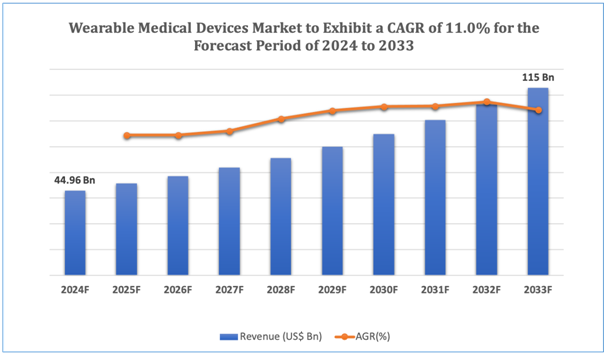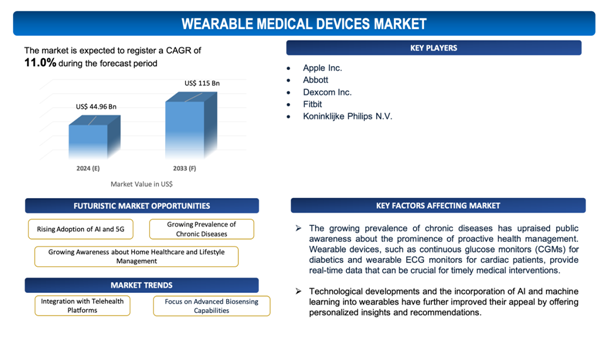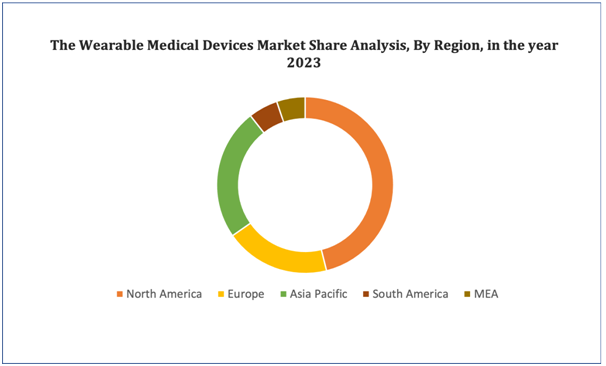Wearable Medical Devices Market Overview
The global wearable medical devicesmarket is estimated to be worth over USD 115 Bn in 2033 and is expected to grow at CAGR of11.0% during the forecast period (2024-2033).
Wearable medical devices are transforming health and fitness panorama by offeringadvanced technologies such as real-time monitoring, data analytics, and personalized insights, therebyrevolutionizing lifestyles globally. These devices, comprising fitness trackers, smartwatches, and biosensors, smoothlyincorporate into daily routines, providinginecessant tracking of vital signs such as blood pressure,heart rate, and glucose levels. The swift escalation of wearable technology is encouraging individuals to take proactive control of their health, allowing early detection of potential health issues and facilitating a preventive approach to healthcare. Fitness enthusiasts benefit substantially from wearables, which providethoroughevaluation of sleep patterns, physical activities, and caloric intake, thussupporting optimized workout regimens and balanced diets. The incorporation of advanced technologies like AI and machine learning improves the accuracy and predictive capabilities of these devices, offering personalized health recommendations on the basis of comprehensive data analysis.
Wearable medical devices are also revolutionizing chronic disease management. For example, continuous glucose monitors (CGMs) offer diabetic patients real-time insights into their blood sugar levels, allowingimproved management of their condition. In a similar manner, wearable ECG help monitors determineunusual heart rhythms, potentially avoidingserious cardiac events. The accessibility and convenience of these devices encourage adherence to medical advice and treatment plans, resulting in enhanced health outcomes.
Along with that, the data gathered from wearables contribute to extensive healthcare research, allowing the development of more effective treatments and health interventions. The incorporation of wearable data with electronic health records (EHRs) is promoting a more holistic view of patient health, improving clinical decision-making and personalized care. Regardless of these constraints such as data privacy concerns and the necessity for persistent technological advancements, wearable medical devices are undeniably transforming the health and fitness paronama, fostering a more engaged and health-conscious global population.
Figure 1. Wearable Medical Devices: Market Size

Get more details on this report - Request Free Sample
Key Market Insights
The global wearable medical device market is experiencingrobust growth, fuelled by technological progressions and growing consumer health awareness. Latest market insights reveal a rise in demand for devices like fitness trackers, smartwatches, and biosensors that provide real-time health monitoring and data analytics. Significant developments comprise the incorporation of AI and machine learning, improving the accuracy and predictive capabilities of these devices, and allowing personalized health recommendations. The market panorama is marked by a greater degree of innovation, with companies emphasizing on developing multi-functional devices that cater to a broad range of health metrics, from cardiovascular monitoring to sleep analysis.
Novel technologies such as continuous glucose monitoring (CGM) systems and wearable ECG monitors are specificallyrevolutionary, acknowledging chronic disease management and preventive healthcare. Partnerships between tech giants and healthcare providers are fostering the development of sophisticated wearable solutions that seamlessly integrate with electronic health records (EHRs), enhancing patient care and clinical decision-making. The surge of telehealth and remote patient monitoring, accelerated by the COVID-19 pandemic, has further accelerated market growth, emphasizing the prominence of wearable devices in advanced healthcare. Regardless of these challenges like data privacy concerns and regulatory hurdles, the market is poised for continued expansion, led by innovation and a soaring focus on personalized, proactive health management.
Market Dynamics
Market Drivers
Growing Awareness about Home Healthcare and Lifestyle Management
Since healthcare systems across the globecontend with soaring patient loads and increasing costs, there is a noticeable shift towards at-home care solutions that provide convenience and cost-effectiveness. Wearable medical devices fit smoothly into this paradigm, offeringincessant health monitoring without the need for frequent hospital visits. These devices allow individuals to manage chronic conditions such as diabetes, hypertension, and cardiac disorders from the comfort of their homes, thusminimizing the burden on healthcare facilities and enhancing patient quality of life.
The growing prevalence of chronic diseases has upraised public awareness about the prominence of proactive health management. Wearable devices, such as continuous glucose monitors (CGMs) for diabetics and wearable ECG monitors for cardiac patients, provide real-time data that can be crucial for timely medical interventions. In addition, the rising focus on lifestyle management and preventive healthcare is accelerating demand for fitness trackers and smartwatches that monitor physical activity, sleep patterns, and vital signs. This data encourage users to make informed decisions about their health, fostering a more health-conscious and engaged population.
Technological developments and the incorporation of AI and machine learning into wearables have further improved their appeal by offering personalized insights and recommendations. The COVID-19 pandemic has also propelled the adoption of telehealth and remote monitoring solutions, underlining the significance of wearables in managing health remotely. As consumers become more educated about the benefits of continuous health monitoring and proactive care, the demand for wearable medical devices is anticipated to continue its upward trajectory, fuelling market growth and innovation.
Market Restraints
With regard to numerous advantages of Wearable Medical Devices, the market faces several challenges due to the unique characteristics and requirements associated with these potent pharmaceutical products. Some of the key market challenges include:
- Data Privacy and Security Concerns: The accumulation and storage of sensitive health data by wearable medical devices elevateconsiderable privacy and security issues. Users are progressively wary of potential breaches and unauthorized access to their personal health information. This concern is combined by changing regulations across regions, which can entangle compliance for manufacturers and impede the adoption of wearables.
- High Cost and Accessibility Issues: The initial cost of innovative wearable medical devices can be restrictive for several consumers, particularly in developing regions. In addition to that, continuous expenses associated withsubscriptions, maintenance, and updates can further prohibit accessibility. This cost barrier can deter widespread adoption, specifically among lower-income populations, thus impeding market growth.

Get more details on this report - Request Free Sample
Market Opportunity
Rising Adoption of AI and 5G
The rising adoption of AI and 5G technology stands as a lucrative market opportunity for the global wearable medical devices market. AI improves the functionality of wearable devices by allowingurbane data analysis, predictive analytics, and personalized health insights. These capabilities enable wearables to offer real-time, precise monitoring and early detection of health issues, thusenhancing patient outcomes and facilitating proactive health management. AI-driven features such as anomaly detection and automated health alerts can notably benefit users, specifically those administering chronic conditions.
The implementation of 5G technology further intensifies the potential of wearable medical devices by providing ultra-fast, reliable connectivity. This allows seamless real-time data transmission between wearables and healthcare providers, supportingtimely interventions and continuous remote monitoring. The low latency and high bandwidth of 5G networks promote advanced telehealth services and the incorporation of wearables with other smart health devices, creating a comprehensive health ecosystem.
Collectively, AI and 5G improve the user experience, making wearables more appealingand efficient. They also allow the development of more cultured and multifunctional devices, fuelling innovation in the market. As these technologies become more prevalent, they are estimated to substantiallypropel the adoption and growth of wearable medical devices worldwide.
Market Trends
- Integration with Telehealth Platforms: Wearable medical devices are essentially being incorporated with telehealth platforms, supporting remote patient monitoring and virtual consultations. This trend has been propelled by the COVID-19 pandemic, which underscored the need for remote healthcare solutions. Through seamless data sharing between wearables and telehealth services, healthcare providers can monitor patients' health in real-time, provide timely interventions, and minimize the need for in-person visits.
- Focus on Advanced Biosensing Capabilities: There is a soaring trend towards developing wearable devices with advanced biosensing capabilities that can monitor a wider range of health metrics. This includes not only standard measurements like heart rate and activity levels but also more complex metrics such as glucose levels, blood oxygen levels, and even stress indicators. These developments are fuelled by continuous research and development efforts, aiming to make wearables more comprehensive and valuable tools for personalized health management and chronic disease management.
Wearable Medical Devices Market: Key Segments
By Product
- Trackers
- Smartwatch
- Patches
- Smart Clothing
By Type
- Diagnostic & Monitoring Devices
- Vital Sign Monitoring Devices
- Multiparameter Trackers
- ECG/Heart Rate Monitors
- Blood Pressure Monitors
- Pulse Oximeters
- Glucose Monitoring Devices
- Sleep Monitoring Devices
- Wrist Actigraphs
- Polysomnography Devices
- Fetal Monitoring & Obstetric Devices
- Neuromonitoring Devices
- Vital Sign Monitoring Devices
- Therapeutic Devices
- Pain Management Devices
- Rehabilitation Devices
- Respiratory Therapy Devices
- Insulin Pumps
By Grade
- Consumer-Grade Wearable Healthcare Devices
- Clinical-Grade Wearable Healthcare Devices
By Distribution Channel
- Online Channels
- Pharmacies
- Hypermarkets
By Application
- General Health and Fitness
- Remote Patient Monitoring
- Home Healthcare
By Key Geographical Regions
- North America
- Europe
- Asia-Pacific
- Middle East and Africa
- South America
Figure 4. Wearable Medical Devices Market: Distribution by Region

Get more details on this report - Request Free Sample
Wearable Medical Devices Market: Regional Analysis
North America accounted for the largest revenue share in 2023, due to the increasing prevalence of cardiovascular disorders, diabetes, and cancer within this region. High adoption of remote patient monitoring and home care devices for regular, continuous, and long-term monitoring of patients and minimizing the frequency of hospital visits are estimated to accelerate market growth over the forthcoming years.
Leading Wearable Medical Devices Developers
Industry Trends and Global Forecasts, 2023-2035 report features an extensive study of the current market landscape, market size and future opportunities associated with the Wearable Medical Devicesmarket, during the given forecast period. Further, the market report highlights the efforts of several stakeholders engaged in this rapidly emerging segment of the biopharmaceutical industry. Key takeaways of the Wearable Medical Devicesmarket are briefly discussed below.
The report includes the list of players operating in the global wearable medical devices market. Some of the key players include:
- Apple Inc.
- Abbott
- Dexcom Inc.
- Fitbit
- Koninklijke Philips N.V.
Wearable Medical Devices Market: Key Developments
- In June 2023, US-based digital health company STAT Health has introduced a 24/7 in-ear wearable general wellness product that measures blood flow to the head to allow a better understanding of conditions in the body that occur upon standing.
- In August 2022, The preventive healthcare devices player, GOQii, has introduced Smart Vital Ultra and GOQii Stream devices targeted at the young adults and youth, encouraging them to lead a healthy and active lifestyle.
Scope of the Report
The market report presents an in-depth analysis of the various firms / organizations that are engaged in this market, across different segments, as defined in the below table:
|
|
Key Report Attributes |
Details |
||
|
|
Base Year |
2023 |
||
|
|
Forecast Period |
2024-2033 |
||
|
|
CAGR (2024-2033) |
11.0% |
||
|
|
Product |
|
||
|
|
Type |
|
||
|
|
Grade |
|
||
|
|
Distribution Channel |
|
||
|
|
Application |
|
||
|
|
Key Geographical Regions |
|
||
|
Key Companies Profiled |
|
|
||
